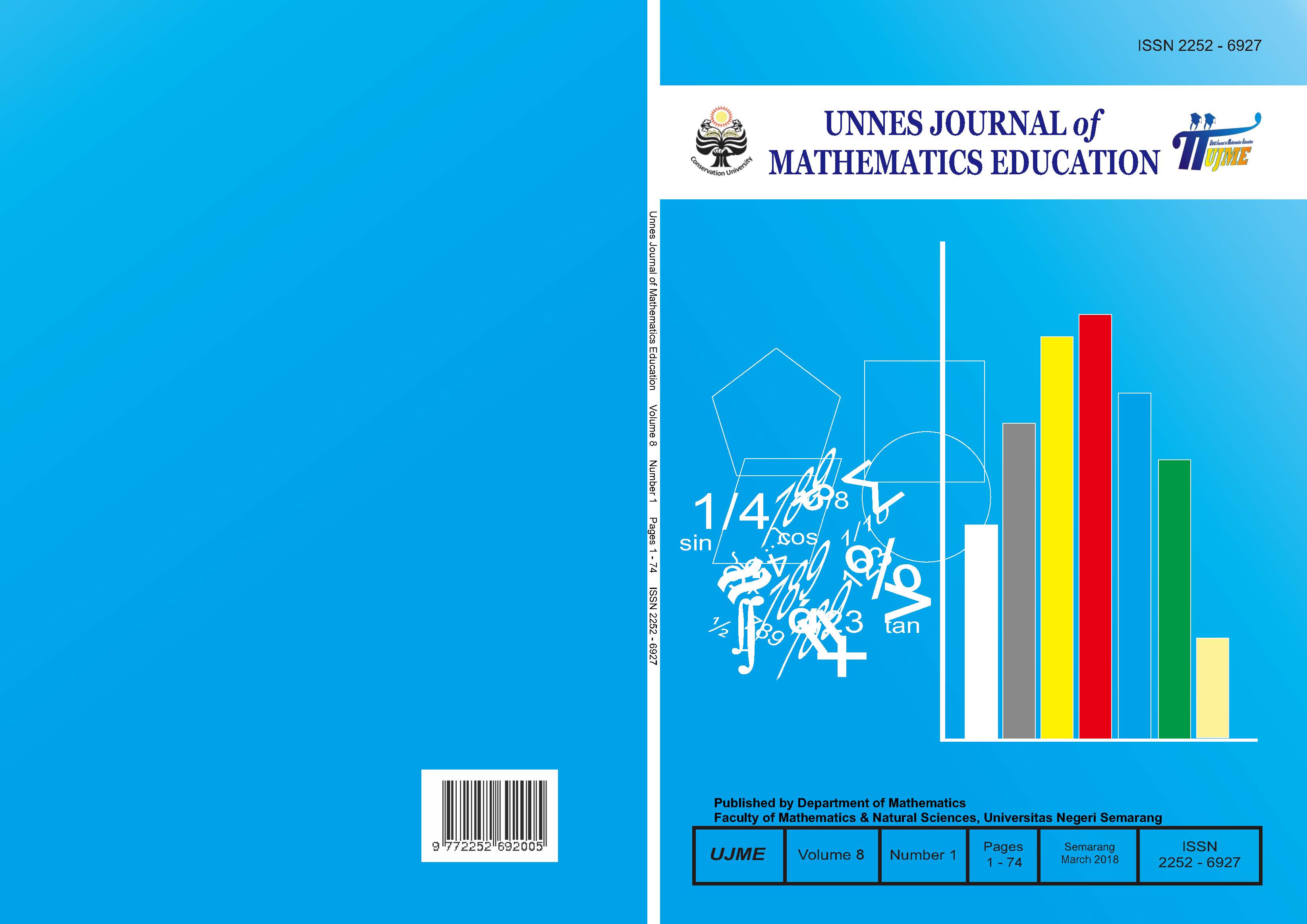The ability of mathematical creative thinking viewed from student learning interest of class VIII in learning CPS contextual approach
##plugins.themes.academic_pro.article.main##
Abstract
The purpose of this study was to determine the effectiveness of Creative Problem Solving learning model with a contextual approach to students' mathematical and creative thinking ability. The population in this study were all students of class VIII SMP Mataram Semarang academic year 2017/2018 spreading in four classes. Sampling was done with selected random sampling technique and resulted class VIII-A as control group and VIII-C as experimental group. Data collection methods used were the test of creative thinking ability, the scale of interest in learning, observation and interview. Proportion test results obtained z_calculation = 2.77 then h_i was accepted, so it can be concluded the percentage of classical completeness. The t test results showed that the difference of two average obtained t_hitung = 8.63 and z_table = 1.68. Since t_calculation > t_table, it can be concluded that the mean of mathematical creative thinking abilities test of experimental class students who got CPS learning with contextual approach was more than the average of the data of mathematical creative thinking abilities tested in control group which achieved Discovery Learning. The proportion difference test resulted z_hitung = 5.67 and z_tabel = 1.64. Since z_count> z_tabel, the proportion of thorough students in the class using the CPS model with contextual cognition was greater than the proportion of students who completed the study in the classroom using the Discovery Learning model. From the result of difference test of average and proportion, it can be concluded that result of the test of the ability of mathematical creative thinking on students in experimental group which applied Creative Problem Solving learning with contextual approach was better than the control group which applied Discovery Learning. Based on the analysis, it can be known the implementation result of Creative Problem Solving learning model with an effective contextual approach in the delivery of material probability class VIII SMP Mataram Seamrang academic year 2017/2018. Students with a high learning interest had a high level of creative thinking ability. Students with fair interest in learning gained enough criterion. Meanwhile, students who had a low interest in learning had low level of creative thinking ability.
##plugins.themes.academic_pro.article.details##
References
Cahyono, A.N. 2007. Pengembangan Model Creative Problem Solving (CPS) Berbasis Teknologi dalam Pembelajaran Matematika di SMA. Tesis. Semarang: Pascasarjana UNNES.
Creswell, J.W., Klassen, A.C., Plano Clark, V.L. and Smith, K.C., 2011. Best practices for mixed methods research in the health sciences. Bethesda (Maryland): National Institutes of Health, pp.2094-2103
Hajiyakhchali, A., 2013. The Effects of Creative Problem Solving Process Training on Academic Well-being of Shahid Chamran University Students. Procedia-Social and Behavioral Sciences, 84, pp.549-552.
Junaedi, I., Suyitno, A., Sugiharti, E., & Eng, C. K. (2015). Disclosure Causes of Students Error in Resolving Discrete Mathematics Problems Based on NEA as A Means of Enhancing Creativity. International Journal of Education, 7(4), 31-42.
Masrukan. 2008. Kemampuan Pemecahan Madalah dan Komunikasi Matematia, Pengaruh Penggunaan Model Pembelajaran dan Asesmen Kinerja Terhadap Kemampuann Pemecahan Masalah dan Kemampuan Komunikasi Matematika. (Doctoral dissertation, Universitas Negeri Jakarta).
Masrukan. 2017. Asesmen Otentik Pembelajaran Matematika, Mencakup Asesmen Afektif dan Karakter. Evaluasi Pendidikan. Semarang: FMIPA Unnes. ISBN : 978-602-14724-6-0.
Mayasari, P., Halim, A., & Ilyas, S. (2013). Model Pembelajaran Creative Problem Solving Untuk Meningkatkan Penguasaan Konsep Dan Keterampilan Generik Sains Siswa SMP. Jurnal Pendidikan Sains Indonesia, 1(1), 58-67
Muslich, Masnur. 2008. Model Pembelajaran Creative Problem Solving (CPS) dengan Video Compact Disk dalam Pembelajaran Matematika. KTSP Pembelajaran Berbasis Kompetensi dan Konstektual. Jakarta: PT Bumi Aksara.
NCTM. 2000. Principles and Standards for School Mathematics. Amerika:The National Council of Teachers of Mathematics, Inc.
Rifa’i, A. dan C.T. Anni. 2009. Psikologi Pendidikan. Semarang: Universitas Negeri Semarang Press.. 2011. Psikologi Pendidikan. Semarang:UPT Unnes Press.
Rochmad, et all.2018. Misconception as a Critical and Creative Thinking Inhibitor for Mathematics Education Students. Unnes Journal of Mathematics Education. ISSN: 2252-6927.
Siswono.2010. Penjenjangan Kemampuan Berpikir Kreatif dan Identifikasi Berpikir Kreatif Siswa Dalam Memecahkan dan Mengajukan Masalah Matematika. Disertasi. PPs UNESA Surabaya.
Sudjana. 2005. Metoda Statistika. Bandung: Tarsito.
Sugiyono. 2014. Metode Penelitian Kuantitatif, Kualitatif, dan R&D. Bandung: CV. Alfabeta.
_______. 2015a. Metode Penelitian Kuantitatif, Kualitatif, dan R&D. Bandung: CV. Alfabeta..
